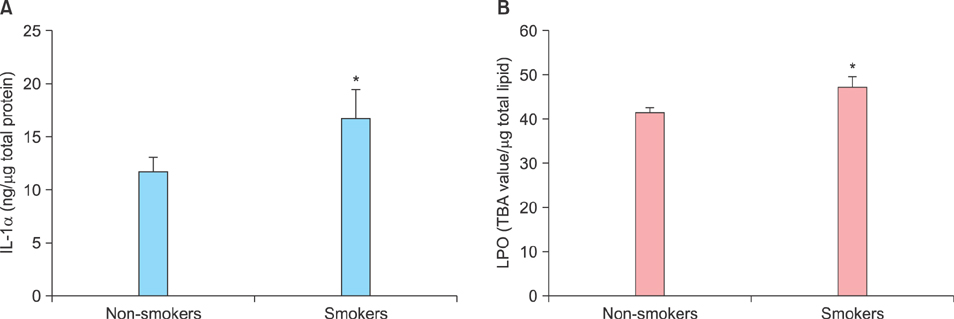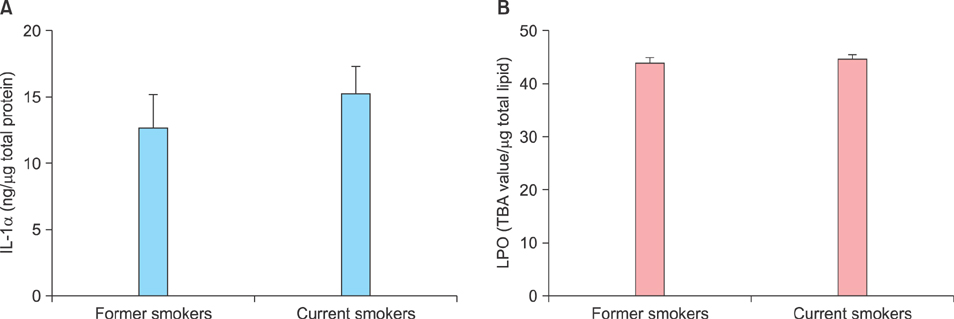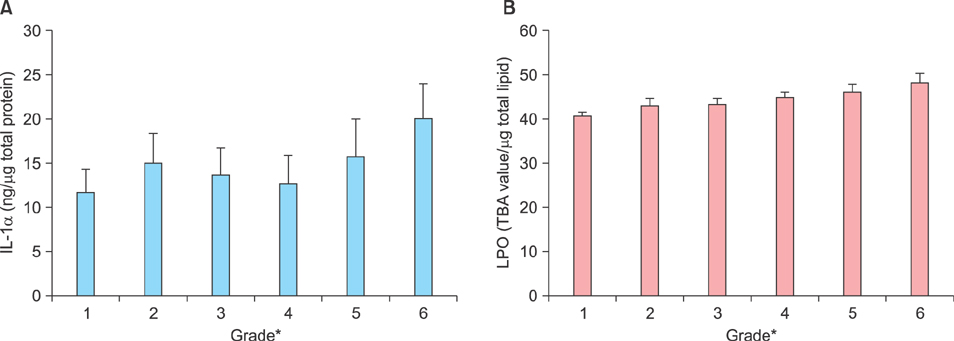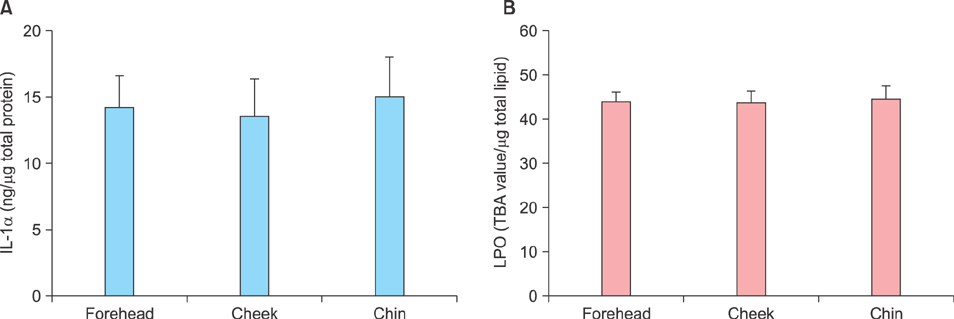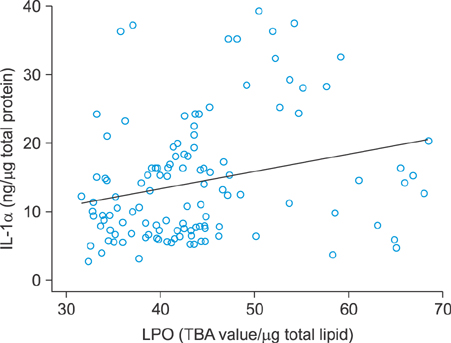Ann Dermatol.
2014 Feb;26(1):11-16. 10.5021/ad.2014.26.1.11.
Cigarette Smoke-Induced Interleukin-1 Alpha May Be Involved in the Pathogenesis of Adult Acne
- Affiliations
-
- 1Department of Dermatology, Kyung Hee University School of Medicine, Seoul, Korea. nikim@khmc.or.kr
- 2East-West Medical Research Institute, Kyung Hee University, Seoul, Korea.
- 3School of Medicine, Loma Linda University-Adventist Health Sciences Institution, Loma Linda, CA, USA.
- KMID: 2265692
- DOI: http://doi.org/10.5021/ad.2014.26.1.11
Abstract
- BACKGROUND
Lipid peroxide (LPO) in comedones, which are produced as a result of sebum oxidation, might potentially induce interleukin-1alpha (IL-1alpha) and exacerbate comedogenesis and inflammatory changes in comedones.
OBJECTIVE
To investigate the relationship of proinflammatory cytokines and LPO levels in the extracts of comedones with the acne of clinical difference between smokers and non-smokers, and with the severity and distribution of the acne lesions.
METHODS
Twenty-two non-smoking and 21 smoking adult acne patients were evaluated by comedone extraction and measurement of proinflammatory cytokines and LPO levels. Acne severity and distribution of the lesions were also analyzed.
RESULTS
Relative to the non-smoking group, smokers had significantly higher levels of IL-1alpha and LPO in comedones. Their levels showed a positive correlation. However, there were no statistically significant difference between the severity or distribution of the disease and the levels of LPO and IL-1alpha in comedones.
CONCLUSION
Smoking may be involved in the pathogenesis of adult acne by increasing the oxidative stress that results in subsequent accumulation of LPO in comedones.
Keyword
MeSH Terms
Figure
Reference
-
1. Goulden V, Clark SM, Cunliffe WJ. Post-adolescent acne: a review of clinical features. Br J Dermatol. 1997; 136:66–70.
Article2. Williams C, Layton AM. Persistent acne in women: implications for the patient and for therapy. Am J Clin Dermatol. 2006; 7:281–290.3. Rivera R, Guerra A. Management of acne in women over 25 years of age. Actas Dermosifiliogr. 2009; 100:33–37.
Article4. Shin MK, Kim NI. Clinical manifestation and elevated serum insulin-like growth factor-1 (IGF-1) levels with post-adolescent acne. Korean J Dermatol. 2008; 46:619–626.5. Ascenso A, Marques HC. Acne in the adult. Mini Rev Med Chem. 2009; 9:1–10.
Article6. Møller P, Wallin H, Knudsen LE. Oxidative stress associated with exercise, psychological stress and life-style factors. Chem Biol Interact. 1996; 102:17–36.
Article7. Wang L, Muxin G, Nishida H, Shirakawa C, Sato S, Konishi T. Psychological stress-induced oxidative stress as a model of sub-healthy condition and the effect of TCM. Evid Based Complement Alternat Med. 2007; 4:195–202.
Article8. Abulnaja KO. Oxidant/antioxidant status in obese adolescent females with acne vulgaris. Indian J Dermatol. 2009; 54:36–40.
Article9. Bhat VM, Cole JW, Sorkin JD, Wozniak MA, Malarcher AM, Giles WH, et al. Dose-response relationship between cigarette smoking and risk of ischemic stroke in young women. Stroke. 2008; 39:2439–2443.
Article10. Sung KJ, Rho YS, Choi EH, Oh JJ, Lee JH, Kim S, et al. Korean acne grading system. Korean J Dermatol. 2004; 42:1241–1247.11. Capitanio B, Sinagra JL, Ottaviani M, Bordignon V, Amantea A, Picardo M. Acne and smoking. Dermatoendocrinol. 2009; 1:129–135.
Article12. Arican O, Kurutas EB, Sasmaz S. Oxidative stress in patients with acne vulgaris. Mediators Inflamm. 2005; 2005:380–384.
Article13. Briganti S, Picardo M. Antioxidant activity, lipid peroxidation and skin diseases. What's new. J Eur Acad Dermatol Venereol. 2003; 17:663–669.
Article14. El-Akawi Z, Abdel-Latif N, Abdul-Razzak K. Does the plasma level of vitamins A and E affect acne condition? Clin Exp Dermatol. 2006; 31:430–434.
Article15. Kim WH, Park EJ, Park MW, Cho HS, Kim HJ, Kim CW, et al. Decreased hydrogen peroxide generation by neutrophils from acne patients treated with isotretinoin. Ann Dermatol. 2006; 18:59–63.
Article16. Klock J, Ikeno H, Ohmori K, Nishikawa T, Vollhardt J, Schehlmann V. Sodium ascorbyl phosphate shows in vitro and in vivo efficacy in the prevention and treatment of acne vulgaris. Int J Cosmet Sci. 2005; 27:171–176.
Article17. Wollina U, Knöll B, Prüfer K, Barth A, Müller D, Huschenbeck J. Synthetic wound dressings--evaluation of interactions with epithelial and dermal cells in vitro. Skin Pharmacol. 1996; 9:35–42.
Article18. Tochio T, Tanaka H, Nakata S, Ikeno H. Accumulation of lipid peroxide in the content of comedones may be involved in the progression of comedogenesis and inflammatory changes in comedones. J Cosmet Dermatol. 2009; 8:152–158.
Article19. Ottaviani M, Alestas T, Flori E, Mastrofrancesco A, Zouboulis CC, Picardo M. Peroxidated squalene induces the production of inflammatory mediators in HaCaT keratinocytes: a possible role in acne vulgaris. J Invest Dermatol. 2006; 126:2430–2437.
Article20. Eady EA, Ingham E, Walters CE, Cove JH, Cunliffe WJ. Modulation of comedonal levels of interleukin-1 in acne patients treated with tetracyclines. J Invest Dermatol. 1993; 101:86–91.
Article21. Ingham E, Eady EA, Goodwin CE, Cove JH, Cunliffe WJ. Pro-inflammatory levels of interleukin-1 alpha-like bioactivity are present in the majority of open comedones in acne vulgaris. J Invest Dermatol. 1992; 98:895–901.
Article
- Full Text Links
- Actions
-
Cited
- CITED
-
- Close
- Share
- Similar articles
-
- Acne Inversa: Evaluating Antimicrobial Peptides and Proteins
- Acne Conglobata Induced by Anabolic Androgenic Steroids
- The Comparison of the Effect of Cigarette and Stop Smoking-aiding Cigarette on Release of IL-6 from Bronchial Epithelial Cell
- Immunohistochemical studies of Interleukin-8 and Tumor necrosis factor-alpha on psoriatic lesions
- Tumor Necrosis Factor-alpha, Interleukin-6 and Interleukin-8 Levels in Tears of Patients with Keratoconus

